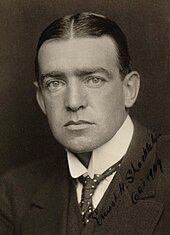Felix König
On his return to Austria, König sought to continue Filchner's unfinished work, and for this purpose organised an Austrian Antarctic Expedition, which he hoped would depart in the summer of 1914.
Attempts to reconcile the two ventures failed; in the event, König's expedition was abandoned in August 1914 on the outbreak of the First World War, in which he served as an officer in the Austrian army.
[14] During the course of the winter drift, König participated with Filchner in an ice journey to investigate the location of land reportedly sighted by the American sealer Benjamin Morrell in 1823.
[8] Here, the expedition dissolved; back in Germany, Filchner was largely exonerated from blame for the debacle, but had lost his taste for polar exploration, and decided to return to his original field of work, in Central and East Asia.
He began to organise the Austrian Antarctic Expedition, and with the backing of the influential Count Johann Wilczek, was able to buy Deutschland, the name of which he changed to Osterreich.
[22][23] When, in January 1913, Shackleton learned that Filchner had failed in his principal objective, he felt free to develop his own scheme, based on the establishment of winter quarters in Vahsel Bay.
[18][3] The former president of the Royal Geographical Society, Sir Clements Markham, still an influential figure, concurred: "One has to leave the area to König where he has worked in former times".
Shackleton then had reluctantly deferred to Scott only to be forced by circumstances, when in the Antarctic, to break his promise and establish his base within McMurdo Sound.
[3][27] Events were then overtaken by the crisis developing in Europe; on 3 August, with war imminent, Shackleton's ship Endurance was moored at Ramsgate, awaiting instructions from the Admiralty.
[3] König joined the Austrian army, fought in Galicia, and in September 1915 was captured and sent to Krasnoyarsk in Siberia as a prisoner of war.



